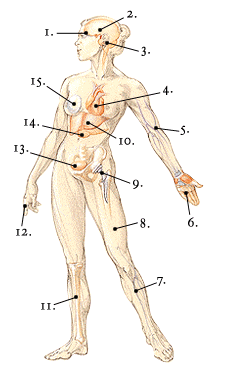 Brain Implants of human or animal nerve tissue into brain are being tried for Parkinson's disease.
Brain Implants of human or animal nerve tissue into brain are being tried for Parkinson's disease.
In the future, versatile brain stem cells may be used to restore dying cells involved in Alzheimer's,
Parkinson's, Huntington's, and
other diseases.
 Heart
Human transplants are routine but limited by organ supply. Heart valves can be replaced by mechanical devices or taken from cadavers.
Large arteries like the aorta can be replaced.
Heart
Human transplants are routine but limited by organ supply. Heart valves can be replaced by mechanical devices or taken from cadavers.
Large arteries like the aorta can be replaced.
Mechanical heart replacement remains experimental. Tissue engineers are trying to grow heart valves in the lab.
 Blood vessels
Researchers are growing small-diameter arteries on polymer scaffolds lined with two layers of cells.
Blood vessels
Researchers are growing small-diameter arteries on polymer scaffolds lined with two layers of cells.
Could replace diseased arteries.
In the future, stem cells may be used to fill in bone gaps.
 Hand
Hand
Mechanical prosthetic hands are improving.
First human hand transplants (from cadaver) appear
promising.
 Nerves
Nerves
Nerves in the limbs can be repaired and can regenerate.
Electricity-conducting polymer nerve
replacements are in research. Work toward eventual regeneration
of damaged spinal cord is promising but success appears far off.
 Skin
Synthetic skin substitutes and sheets of material containing living skin
cells are now used to treat burns and severe skin ulcers.
Skin
Synthetic skin substitutes and sheets of material containing living skin
cells are now used to treat burns and severe skin ulcers.
 Liver
Transplants are
common.
Liver
Transplants are
common.
Researchers have grown tissues with some liver functions, but creating an
entire liver is beyond today's science.
 Finger joint
Knuckles can be replaced with metal joints.
Finger joint
Knuckles can be replaced with metal joints.
Recently, tissue
engineering was used to form a finger joint, but it was not implanted
in patients.
 Pancreas
Pancreas transplants are performed now.
Pancreas
Pancreas transplants are performed now.
Transplants of
pancreatic beta-cells, which make insulin, are still in development stage for treating
diabetes.



![]()
![]()





